Maybe I’ll mention this and then we’ll have a break.
When the I appears back to us not merely labeled by mind, within that, there are also other very gross hallucinations. The Vaibhashika school has eighteen schools, and for one of the schools the root of samsara is that the I, which is impermanent in nature, appears permanent, and we hold on to that. That concept of permanence is a wrong concept. Then the I exists alone without depending on parts. We hold that concept as true. Then, the I appears to be independent, existing with its own freedom; it appears like this and we hold on to that as true. According to this part of the Vaibhashika school, this wrong concept is the root of samsara, the root of suffering, but the reality is that, although this is a wrong concept, it is not the root of samsara.
The I also appears to be self-sufficient, without depending on the collection of the aggregates and their continuity. The I appears self-sufficient, like a king or president or whoever, without depending on the population. But if there were no population, if nobody was there, how could that person become the president or king? So, like that, without depending on the population, it exists, self-sufficiently. When the I appears back to us in this way, this is also a wrong view. The emptiness of this is the selflessness of the person according to the Vaibhashika school, the Sautrantika school, the Cittamatra school and even the Madhyamaka Svatantrika school.
But that I appearing as self-sufficient and us believing that to be true, that concept is still not the root of samsara. Even though it is believed to be the root of samsara by the previous schools, from the Prasangika school’s point of view, it is not the root of samsara. From the Prasangika school’s view and in reality it is not the root of samsara.
The object to be refuted—the hallucination—according to the Svatantrika school is the I that appears without being labeled by the undefective valid mind, that it appears to exist from its own side. This hallucination is also there. According to them, holding on to that as true is the root of samsara. It might be holding on to the I as self-sufficient.
This concept of the I particularly existing from its own side without appearing to the undefective mind labeling it and the mind holding on to this, this concept is also not the root of samsara [according to the Prasangika].
The root of samsara is only what I mentioned before, when the I appears back after the mere imputation as something extra, something slightly more than that, as existing from its own side. The moment [Rinpoche snaps his fingers] the continuity of the previous mind that has labeled the I holds on to it as true, holds on to that very subtle object, that ignorance is the root of samsara. This is the Madhyamaka Prasangika school’s root of samsara. This is the unmistaken one.
From that, all those other disturbing thoughts, such as ignorance, anger and attachment arise, which motivate karma, and from those arise the true cause of suffering and all the true sufferings: all the oceans of sufferings of the hell realm, the oceans of sufferings of the hungry ghosts, the oceans of sufferings of the animals, the oceans of sufferings of the human beings, the oceans of sufferings of the sura and asura realms, and so on. This all comes from there.
From this, we should get some slight idea which suffering we should be liberated from, what we should look for and what is the root we need to cut, to eliminate. We should get some small idea of that. I think that realizing emptiness is the heart of all Buddhadharma, all 84,000 teachings of the Buddha, the graduated path to enlightenment, the lamrim.
It can be said that 84,000 teachings are contained in the Tripitaka, the three baskets of teachings, that they are all contained in the lamrim, the graduated path to enlightenment, and the heart of all that is the three principal aspects of the path to enlightenment: renunciation, bodhicitta and right view. Here, emptiness is our daily life’s practice. We can see how urgent it is to learn about emptiness, to meditate on it and to realize it.





























